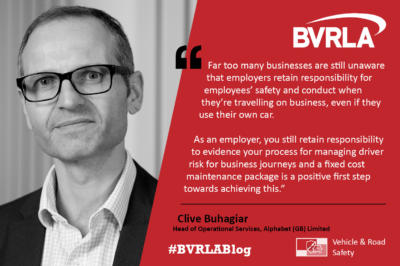Clive Buhagiar, Head of Operational Services at Alphabet (GB) Limited looks at the growing trend for switching from a traditional car scheme to a cash allowance and asks if maintenance costs have been fully considered.

If your organisation offers company cars, you’re likely to have seen a growing tendency for businesses and individuals to consider switching from a traditional car scheme to a cash allowance.
This switch often leads to employees taking a new vehicle on personal contract hire (PCH), but it’s vital that both companies and employees understand their responsibilities in this scenario. The latest figures from the car rental and leasing industry back up this trend, with PCH rising by 24 per cent year-on-year in the last quarter of 2018 [1].
Far too many businesses are still unaware that employers retain responsibility for employees’ safety and conduct when they’re travelling on business, even if they use their own car. Just as many employees aren’t aware that if they use their private vehicle even for a single business journey then this needs to be included in their insurance policy.
But one of the most overlooked factors when switching from a company car to PCH is the issue of maintenance. So, what does your organisation need to know in order to help advise and guide employees when they are considering how to finance and run their next vehicle?
Our latest research among UK drivers revealed that two-thirds of owners have never added up the total cost of how much they spend on their cars in a year [2]. It is not surprising then that employees with a cash allowance only look at the headline PCH cost per month, instead of the total costs of ownership, including insurance, fuel and running costs, as well as everyday ‘wear and tear’ expenses, like new tyres, brakes, batteries, fluids, servicing and MOT. So, while a PCH agreement without a maintenance package may appear money saving, a maintenance package can lower your overall running costs of a vehicle, as well as reducing the risk of unexpected bills.
When selecting a PCH contract, it is vital drivers are realistic from the outset and accurately estimate their annual mileage. Unlike traditional company car schemes, additional contract mileage and associated maintenance costs are borne by the drivers themselves. Again, employees might think they’re saving money each month by ‘chancing it’ with their mileage, but you’ll undoubtedly face costs if you return the vehicle over its agreed mileage at the end of contract.
So, are your employees and drivers prepared for likely servicing costs in future? Do they have a plan in place in case their vehicle is off-the-road for a while due to maintenance? Are they prepared to meet scheduled maintenance intervals on time to ensure the vehicle is safe on the road?
Not only does taking a maintenance package mean the servicing and maintenance costs can be spread over the term of the contract, it also allows employees to enjoy ‘economies of scale’ from their leasing provider. They can benefit from the bargaining power of a large fleet, as well as their expertise and support when dealing with disputes.
Essentially, the question is whether the additional monthly cost of a maintained contract matches the price a driver puts on their own peace of mind. As an employer, you still retain responsibility to evidence your process for managing driver risk for business journeys and a fixed cost maintenance package is a positive first step towards achieving this.
[2] The research carried out by Arlington Research on behalf of Alphabet (GB) Limited questioned 2,000 Brits aged 18 years and over.
Share this blog via your own channels:
Members can download the social media image resources available for free from our Communications Toolkit. Don't forget to tag us #BVRLAblog @bvrla.





